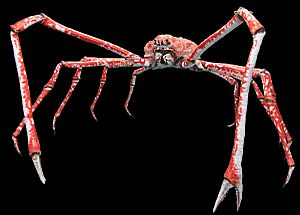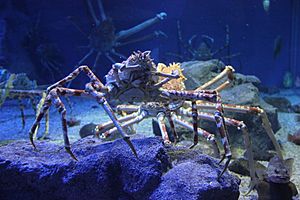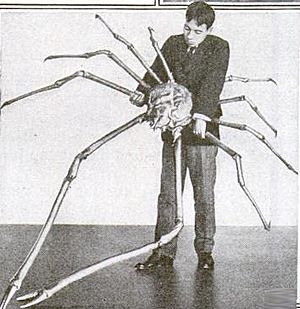Japanese spider crab facts for kids
Quick facts for kids Japanese spider crab |
|
|---|---|
 |
|
| Scientific classification | |
| Kingdom: | |
| Phylum: | |
| Subphylum: | |
| Class: | |
| Order: | |
| Infraorder: | |
| Superfamily: | |
| Family: |
Inachidae
|
| Genus: |
Macrocheira
|
| Species: |
M. kaempferi
|
The Japanese spider crab (Macrocheira kaempferi) is a species of marine crab, and is the only member in the genus Macrocheira. It is found only in the waters around Japan. The Japanese spider crab has the largest leg span of any arthropod in the world, reaching up to 3.8 meters (12 ft) long, and weighing up to 41 pounds (19 kg). It is the subject of fishery and is considered a delicacy.
Contents
Description
The Japanese spider crab has the largest leg span of any arthropod in the world, reaching up to 3.8 meters (12 ft) long, and weighing up to 41 pounds (19 kg), but the actual body of the Japanese spider crab is only 15 inches long. It has 8 legs and 2 arms used for feeding. Each feeding arm is 1.5 meters (5 ft) long. It is orange in colour, with white spots on its legs. Although this crab has some ferocious appearances, it is actually known to be very gentle towards others.
Their armored exoskeletons help protect them from larger predators such as octopuses, but giant spider crabs also use camouflage. The crab's bumpy carapace blends into the rocky ocean floor. To further the illusion, a spider crab will adorn its shell with sponges and other animals.
Habitat and distribution
It is found in the Pacific side of the Japanese islands, Konshu and Kyushu. They are found usually in the Sagami, Suruga, and Tosa bays, as well as off the coast of the Kii peninsula. However, a Japanese spider crab was once found as far south as Su-ao, in eastern Taiwan. This is most likely a one time event; it is possible a fishing trawler or extreme weather may have carried this individual much further south than its home range. The Japanese spider crab is found up to the depths of 2,500 feet (750 meters).
Diet
The Japanese spider crab is an omnivore, consuming both plant matter and animals. It also sometimes acts as a scavenger consuming dead animals. Some have been known to scrape the ocean floor for plants and algae while others pry open the shells of mollusks.
Reproduction
Female crabs carry fertilized eggs attached to their abdominal appendages until they hatch into tiny planktonic larvae. They can lay up to 1.5 million eggs per season, and these eggs will hatch in 10 days on average.
Fishery and conservation
The crabs are typically caught using small trawling nets. The population has decreased in number due to overfishing, forcing fishermen into exploring deeper waters to catch them. The average size caught by fishermen is a legspan of 1.0–1.2 m (3 ft 3 in – 3 ft 11 in). Populations of this species of crab have diminished over recent years and many efforts are being made to protect them. One of the primary methods of recovery of the species being used is restocking artificially cultured juvenile crabs in fisheries. Additionally, laws have been put into place in Japan that prohibit fishermen from harvesting spider crabs from January through April, during their typical mating season when they are in shallower waters and more vulnerable to being caught. This protection method seeks to keep natural populations growing, and enables time for juvenile spider crabs to go through the early stages of their lifecycle.
Images for kids
-
Rear view of a Japanese spider crab at Monterey Bay Aquarium
See also
 In Spanish: Macrocheira kaempferi para niños
In Spanish: Macrocheira kaempferi para niños






